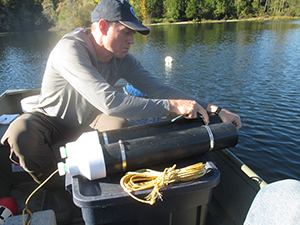A version of this story was originally published in the Summer 2016 UW-SRP e*Bulletin.

Results to date indicate that in stratified lakes, arsenic mobilized from the lake bed sediments remains sequestered in the deep anoxic waters while in the unstratified lakes, the mobilized arsenic is mixed throughout the water column. Because aquatic organisms primarily congregate in oxygenated waters, there is more overlap between arsenic contamination and aquatic life in the fully oxygenated (unstratified) lakes. Consequently, the researchers have found that phytoplankton (floating microalgae) in these lakes bioaccumulate more arsenic than phytoplankton in stratified seasonally anoxic lakes.
Drs. Neumann, Gawel and Barrett have met with local, state and federal agencies to discuss the results of their research to date and the possible implications for public health. Water quality guidelines set to protect human and environment health are currently based on maximum aqueous arsenic concentrations measured within a water body. The results of their study indicate that arsenic concentrations in oxygenated water, rather than maximum arsenic concentrations, may serve as a more relevant metric for assessing arsenic bioavailability in aquatic systems. The investigative team also report progress and results to neighbors, local lake users and residents. Some community members have provided storm water collection. The project also has worked with high school student volunteers who are certified divers to assist with lake sediment sampling. Initial project results were presented by researcher Pamela Barrett this summer at the Gordon Research Conference. Erin Hill, an undergraduate working with the project is submitting a research presentation proposal for the Washington State Lake Protection Association Annual meeting in October, 2016.

